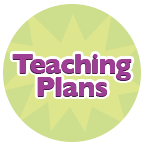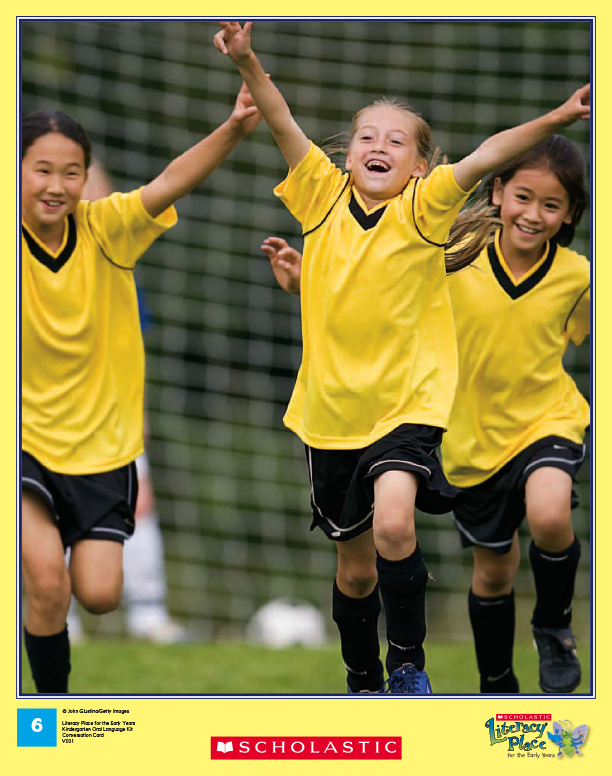Oral Language Teaching Strategy:
Offer Prompts and Frameworks to Reluctant Talkers Offer encouragement, low-key prompts, and adequate thinking time to elicit conversation from shy students.
Time: one 30-minute lesson or two 15-minute lessons
Materials: Emotions/Interactions Card #6
Grouping: whole class or small group
Assessment: Kindergarten Oral Language Assessment Scale
FOCUSING ON THE PICTURE
[Analyzing/inferring]-
It’s important to let people know our ideas but I also know that sometimes we can feel shy to share our thinking. That’s why today we are going to use this puppet to help us talk. The puppet’s name is ____ and it helps us find our voice when we are feeling shy.
Before introducing the picture, tell students that everyone is going to get a chance to share. This prepares all students to be actively involved in the discussion. Introduce a puppet and explain that the puppet is going to help everyone talk.
Teaching Tip: Using props such as a puppet or talking stick can sometimes encourage reluctant talkers to share their ideas. Keep the props in an accessible place for students to use whenever they feel they need it.
What do you think is happening in the picture? Why do you think the girl has her hands in the air? Anna, what do you think is happening? I will give you a minute to think and then come back to you.
[Analyzing/inferring]- Have students sit in a circle so everyone can see the picture. Give students time to analyze the picture, giving prompts to deepen their observations.
-
After students have had time to analyze the picture, have them turn to a partner and share their thinking. Remind them to make sure each partner has a turn to share. Monitor pairs that have reluctant talkers in them and prompt those students by asking, “What do you want to share with your partner?”
- Provide time for partner discussion and then pass the puppet around the circle, giving each student an opportunity to share. Allow each student one pass but give them another chance to share at the end of the discussion.
[Inferring/analyzing]
- Build on what the students have to say, offering prompts to stimulate discussion:
- Who are the people in the picture?
- What is happening in the picture?
- What are these girls wearing? What does that tell you?
GOING DEEPER
[Inferring/evaluating]If you were this girl, how would you feel? Angelique, you think that you would be happy. How would you act if you were happy?
Offer open-ended prompts that focus the students on the emotions portrayed in the picture:- How do you think the girl is feeling? What clues tell you this?
- What is her mouth doing? Her eyes? Her arms?
- What do you think the girl would say after this happened?
What would you say if you were this girl? - How do you think the other two girls are feeling? How do you know?
- Before ending the lesson, have students reflect on how the puppet helped them share their thinking. Invite a few students to share their thinking and remind students that they can use this puppet whenever it helps them.
You may conclude the lesson at this point and do the second part on the next day, or you may decide to continue and do Connecting and Predicting as part of the first lesson.
CONNECTING
Teaching Tip: If you decide to do Connecting and Predicting on the second day, begin your lesson by reviewing the picture with the students.
[Making connections]
- Have students draw on their personal experiences to make connections to this picture by discussing the sports they play. Prompts to deepen discussion might include:
- Have you ever felt like the girl in this picture? How did you feel?
- How are the other girls feeling? How do know?
- Have you ever lost a game? How did you feel then?
- How do they think the other team is feeling?
- How do you think the goalie on the other team is feeling?
Have you ever scored a goal or won a game? How did it make you feel? What did you do?
Offer specific prompts that fit the discussion you have had with the group.
PREDICTING
[Predicting]-
What do you think just happened? Why do you think this?
Ask students to think about what just happened and what might happen next in this picture.
-
Brainstorm with students what the girl might say after this picture. Invite students to share their ideas. Make sure to ask students why they think the girl might say this to ensure they are building on the picture and discussions that have taken place.
LESSON EXTENSIONS
- Introduce soccer in gym class. Begin by brainstorming the rules of soccer. Then introduce skill-building activities such as passing, kicking, and scoring. This will allow students to feel confident in their ability to fully participate in the game.
- Have students listen to several different types of music and discuss which music would best match the moment in the picture. Have students dramatize how they would act if they or their teammate just scored a goal to each kind of music.
- Use the picture as a starting point to create a story as a modelled writing lesson. Focus students on rereading what you are writing, spelling words with you, and discussing the conventions (quotation marks, exclamation marks, commas). You can have students come up and be ‘spacers’ by asking them to put their hand on the paper to create a space between words as you write.
FOLLOW-UP IN CENTRES
-
Provide a stick or tube that students can collaboratively decorate at the art centre to create a talking stick for group discussions. This will provide another tool for reluctant talkers to use in discussions. It also gives a visual for students that have difficulty with letting others be heard when it is their turn to speak.
-
Invite students to the drama centre to role-play what happened in the picture using puppets.
-
Have students design and create a trophy for a soccer team who just won a game or a tournament. Invite them to use the trophy as a prop to act out an awards ceremony. Have students choose appropriate music to play at the ceremony.
- Brainstorm with students action words associated with soccer (kicking, running, scoring, cheering, passing). Write these words on cards and show students how to create a found poem by moving the cards around. For example,
|
Soccer |
Students can illustrate the poems they create to include in a class book.
Teaching Tip: Model how to create a found poem before students create their own. By having the words on individual cards, students can play with words, moving them and repeating them until they get the rhythm they like.

